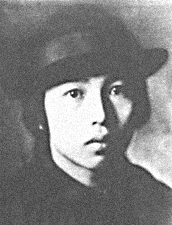Chūya Nakahara
Nakahara Chūya | |
|---|---|
 Nakahara Chūya | |
| Born | 29 April 1907 Yamaguchi Japan |
| Died | 22 October 1937 (aged 30) Kanagawa Japan |
| Occupation | Writer |
| Genre | Poetry |
| Literary movement | Symbolism Dadaism |
Template:Japanese name Chūya Nakahara (中原 中也, Nakahara Chūya) (29 April 1907 – 22 October 1937) was a Japanese poet active during the early Shōwa period of Japan.
Early life
Nakahara Chūya was born in what is now part of the city of Yamaguchi in Yamaguchi Prefecture in 1907, where his father, Nakahara Kansuke, was a highly decorated army doctor. In his early life, his father was posted to Hiroshima and Kanazawa, returning to Yamaguchi in 1914. In 1915, his younger brother died, and in sorrow he turned to composing poetry. He submitted his first three verses to a women’s magazine and local newspaper in 1920, when he was still in elementary school. In 1923, he moved to the Ritsumeikan Middle School in Kyoto, and from April 1924, began living together with the actress Yasuko Hasegawa.
Literary career
Initially, Chūya favored poetry in the Japanese traditional tanka format, but he was later (in his teens) attracted to the modern free verse styles advocated by Dadaist poet Takahashi Shinkichi and by Tominaga Tarō.
After he moved to Tokyo, he met Kawakami Tetsutaro and Ooka Shohei, with whom he began publishing a poetry journal, Hakuchigun (Idiots). He was befriended by the influential literary critic Kobayashi Hideo, who introduced him to the French symbolist poets Arthur Rimbaud and Paul Verlaine, whose poems he translated into Japanese. The influence of Rimbaud went beyond just his poetry, and Nakahara came to be known for his "bohemian" lifestyle.
Chūya adapted the traditional counts of five and seven used in Japanese haiku and tanka, but frequently tripped these counts with variations, in order to obtain a rhythmical, musical effect. Several of his poems were used as lyrics in songs, so this musical effect may have been carefully calculated from the start.
Chūya's works were rejected by many publishers, and he found acceptance primarily with the smaller literary magazines, including Yamamayu, which he launched together with Kobayashi Hideo, (although on occasion Shiki and Bungakukai would condescend to publish one of his works). He remained close friends with Kobayashi all of his life, despite the fact that in November 1925, Yasuko Hasegawa left Chūya and began living with Kobayashi Hideo instead.
In December 1927, he met composer Saburō Moroi, who later adapted a number of his verses to music.
In April 1931, Chūya was admitted to the Tokyo Foreign Language College in Kanda to study the French language, where he remained until March 1933. Chūya married in December 1933, and his first son was born in October 1934. However, the death of his son in November 1936 sent him into a nervous breakdown from which he never fully recovered. Many of his later poems seem like remembrances and attempts to mitigate this enormous pain.
Chūya was hospitalized in Chiba in January 1937. In February, he was released and moved back to Kamakura. He left a number of his works with Kobayashi Hideo, and was making plans to return to his home town of Yamaguchi when he died in October 1937 at the age of 30 of cerebral meningitis. His grave is at his hometown of Yamaguchi.
Legacy
Only one of his poetry anthologies, Yagi no Uta ("Goat Songs", 1934) appeared while he was alive (in a self-financed edition of two hundred copies). He had edited a second collection, Arishi Hi no Uta ("Songs of Bygone Days") just before his death. During his lifetime, Chūya was not counted among the mainstream of poets, but his verses have a wide and increasing following even to this day. Chūya is now a subject of classroom study in Japanese schools, and his portrait in a hat with a vacant stare is well known. Kobayashi Hideo, to whom Chūya entrusted the manuscript for Arishi Hi no Uta on his deathbed was responsible for the posthumous promotion of his works, and Ooka Shohei for collecting and editing The Complete Works of Nakahara Chūya, a collection containing the poet's uncollected poems, his journals, and many letters.
- A literary award, the Nakahara Chūya Prize, was established in 1996 by Yamaguchi city (with the support of publishers Seidosha and Kadokawa Shoten) in Chūya's memory. The award is presented annually to an outstanding collection of contemporary poetry characterized by a "fresh sensibility" (shinsen na kankaku). The winner receives a cash award of 1 million yen, and for several years, the winning collection was also published in an English language translation, but in recent years, the administrations of the award have stopped translating the winner.
- The acid-folk singer Kazuki Tomokawa recorded two albums entitled Ore no Uchide Nariymanai Uta and Nakahara Chuya Sakuhinnshu, using Nakahara's poems as lyrics.
- In the anime production Space Battleship Yamato 2199, science officer Shiro Sanada is often seen with a collection of Nakahara's poems.
See also
References
- Nakahara, Chuya. (Beville, Ry. Trans.), Poems of Days Past (Arishi hi no uta). American Book Company (2005). ISBN 1-928948-08-1
- Nakahara, Chuya. (Beville, Ry. Trans.), Poems of the Goat. American Book Company (2002). ISBN 1-928948-08-1
ISBN 1-928948-04-9
- Nakahara,Chuya, (Paul Mackintosh,Maki Sugiyama.Trans)The poems of Nakahara Chūya(1993).ISBN 978-0852442555
- Kurahashi, Ken’ichi. Shinso no jojo: Miyazawa Kenji to Nakahara Chuya (Miyazawa Kenji ron sosho). Yadate Shuppan; (1992). ISBN 4-946350-02-0 (Japanese)
- Thunman, Noriko. Nakahara Chuya and French symbolism. University of Stockholm (1983). ISBN 91-7146-314-3
External links
- Fan page in English and Japanese
- Nakahara Chūya Memorial Museum in Yamaguchi (Japanese site)
- e-texts of Chūya's works at Aozora bunko (Japanese site)
- Nakahara Chuya
- Chuya Nakahara Poems
- Works by or about Chūya Nakahara at the Internet Archive
- Works by Chūya Nakahara at LibriVox (public domain audiobooks)

